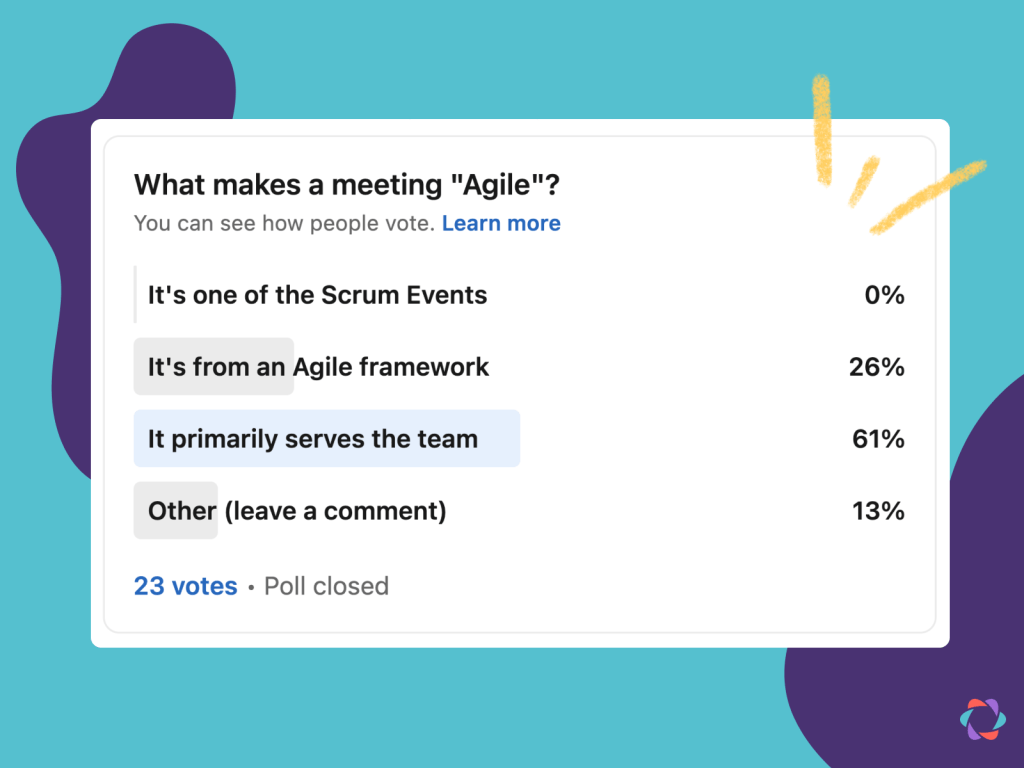Improve any Meeting with Agile Thinking

Take the principles of the Agile Manifesto. Apply those ideas to any team gathering, and, voila, you may have an agile meeting – one that’s more effective, doesn’t run over, that serves the team first, and in which everyone has a say. At least, in theory.
We asked Scrum Masters and Agile Coaches what makes a meeting Agile? The majority responded that you might be able to call a meeting “Agile” if it primarily serves the team.
Some people also felt that Agile meetings can only originate from Agile frameworks.

Unfortunately, it’s not quite that simple.
When we asked Agile coaches, Scrum Masters, and other experts whether any meeting could be improved by applying agile principles, this is what we heard:
- 💬 “There is no need to add the word ‘Agile’ in front… What is a meeting all about? Or better: Why do most meetings suck?”
- 💬 “Rhetorically I would prefer to talk about effective meetings in an agile setup instead of ‘agile meetings’… I try to keep it as simple as possible instead of constantly having to interpret yet another prefixed term.”
- 💬 “For me, a meeting cannot be agile, but a meeting can be planned with the purpose of being agile. Sharing insights, collaborating, creating shared understanding by discussion.”
Equipped with these recommendations and insights, we set off to think about how to embed the principles of the Agile Manifesto into meetings to make team gatherings more effective, inclusive, and… actually agile.
📌 For an overview of the Agile meetings included in Agile frameworks, check out this resource.
Know when to call a meeting
“This meeting could have been an email” is what 32% of people surveyed by SurveyMonkey and Zoom think all or most of the time. The inverse is less recognized but sometimes also true: an email that should have been a meeting.
Face-to-face, synchronous conversation – a tenet of the Agile Manifesto – can be the most effective way to make decisions, communicate, and collaborate, typically when:
- 💢 The topic is sensitive, and the other party needs to see your sincerity, emotions, and body language. You wouldn’t hold a performance review over email (we hope).
- 💬 More than three people need to weigh in on a topic, like when planning, making important decisions, or brainstorming. You know this to be true when you find yourself on an email thread that goes on for days with its messages filling half your screen.
- 📝 A meeting reduces the need for heavy documentation because all stakeholders can be present, or when you can more easily express a point verbally.
Agile coach Chris Wolff also pointed out an excellent middle ground between an email and a meeting you shouldn’t forget about – the conversation.
“Don’t have a meeting, when a conversation will do.”
Sometimes, walking over to someone’s desk or jumping on an ad-hoc, informal call is the most effective way to resolve something and move forward.
For distributed or remote teams that are used to working asynchronously, recording a short video with Loom or the built-in video in Slack can help you reach the same goal.
Plan for your meetings to serve a specific goal
Like all of your Sprints, your meetings should have a goal. Without an objective, it’s near impossible to practice “the art of maximizing the amount of work not done.”
With a goal, every aspect of your meeting – agenda, attendees, duration, and outcomes – can serve the purpose you’ve set out to achieve.
- 🌀 Pare down meetings to just what you need. Agile frameworks like Scrum outline the specific meetings a team should run during a typical sprint, which prevents the problem of too many meetings, and gives each one a clear goal. Non-Agile teams can borrow from this process to ensure that every meeting is serving a specific purpose.
- ✋ Make sure people in the meeting need to be there. It’s important to also ensure the right people attend your meetings and only those. Agile meetings should primarily serve the team, rather than managers or leaders. Too many participants is a common problem that leads to irrelevant discussions and meetings running over. But not having a crucial stakeholder present is equally bad.
- ⏲️ Time-box your meetings. As with the Daily Scrum, every meeting becomes more focused when there is a time limit – so-called time-boxing. This practice forces participants to stay on topic and prevents discussion rabbit holes.
Make meetings results-driven and inclusive
An effective meeting delivers value by helping a team take action and move forward. You make a decision, create a plan, or find a solution to a problem that blocks progress so you can deliver more value to customers.
Many meetings do the opposite. They delay decisions, sabotage plans, and participants leave the room – or Zoom – with more questions than answers. One Agile coach summarized the average meeting: “We speak a lot, but hardly decide anything.”
You can avoid such problems by scrutinizing your meeting outcomes. Do your follow-up actions help the team move forward, or do they give shelter to uncomfortable decisions you should but rather won’t tackle?
Be especially wary of such things happening when all stakeholders needed for a decision are present. Is there truly a valid reason for kicking the can down the road?
At the same time, if a crucial stakeholder is missing, ask yourself why you’re holding the meeting in the first place. And when one person needs to approve every decision but never attends, then your entire organization – not just your meetings – probably needs an agile overhaul.
Make sure introverts are included too
Your meetings can also find themselves burdened with some folks who are too present. They love listening, as long as it’s to the sound of their own voice. To avoid such situations and make sure introverts and less assertive participants have the psychological safety to feel comfortable speaking up:
- ✅ Circulate the agenda in advance so introverts can prepare by familiarizing themselves with the meeting topics.
- ☕ Start every meeting with an icebreaker. Such a question helps participants get to know each other and gives everyone a chance to speak at the start of the meeting.
- 🎙️ Have a meeting facilitator stop people who speak too much and pull in those who don’t. Facilitators can do so by asking either/or questions about a topic. Such propositions let people choose instead of broad questions that require the kind of expansive thinking introverts sometimes need time for.
- ⏰ Time-box each speaker to ensure they don’t get interrupted, and prevent the discussion straying into unrelated territory.
- ✋ Consider not inviting bosses, managers, and other people with imposing titles when they have nothing to contribute. Their presence usually makes everyone else too self-conscious and insecure to contribute meaningfully to the discussion.
📌 For a list of 23 tips to make meetings more inclusive for introverts, check out How to Design Inclusive Meetings for Introverts.
Continuously improve meetings to reduce waste
Continuous improvement means looking for ways to improve work processes constantly. It’s a core principle of Agile that helps teams get better with every Sprint. You can apply the same mindset to your meetings.
To start improving your meetings, you first need insights into which meetings – or which parts of them – are delivering value and which aren’t.
“If at any time you find yourself in any situation where you are neither learning nor contributing – use your two feet and move to someplace more to your liking. Such a place might be another group, or even outside into the sunshine. No matter what, don’t sit there feeling miserable.”
In other words: let people vote with their feet. If they feel a meeting is useless or they can’t contribute, they can decide not to attend or even leave mid-meeting.
The idea may sound radical to the traditional management mind but is fully in line with another agile tenet: trust team members to get the job done and do the right thing.
Another great place to collect input on meeting value is at the end of each one. Ask participants what was valuable to them and what wasn’t. If you’ve created an environment of openness and trust, and senior people – especially those responsible for the meeting – give candid feedback on the gathering, others will follow.
You can use the signals and insights in Sprint Retrospective meetings to discuss how to improve meetings or even which ones to drop. You can either do this through a dedicated Retrospective on meetings or as a fixed agenda item – like “meeting sucks of the month” – for every Retrospective.
Meetings follow culture regardless of what you call them
Just because a meeting is listed in the Scrum Guide doesn’t automatically make it effective. We hear of plenty of organizations running Daily Scrums for half an hour or more.
Other companies can’t fully let go of the past. They commit the deadly sin of keeping their traditional meetings and adding all their shiny new Agile meetings to the calendar, too.
Ultimately, the agility of your meetings depends on how receptive your organization is to the principles we’ve outlined earlier, and that’s largely a matter of culture.
As Timothy Gallwey writes in The Inner Game of Work:
“In a fear-based culture, the desire to look good—or not to look bad—can take precedence over the business objectives at hand and be the hidden driving force in conversations and meetings among co-workers. Other cultures are more obsessed with control and power… These conversations, though often invisible to people in the culture, have great influence on how the workers communicate with one another.”
Your meetings will reflect your organization’s culture. If politics, power, and fear play a large role in the daily life at your company, you have other things to worry about than whether your meetings are agile or not.
If that sounds like your team or organization, start here!









